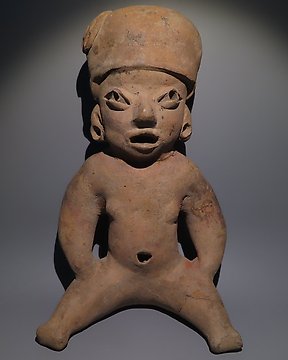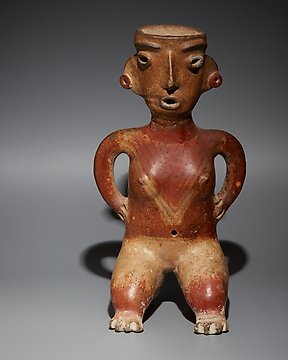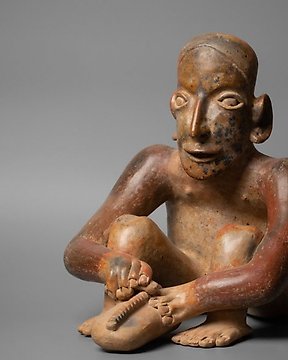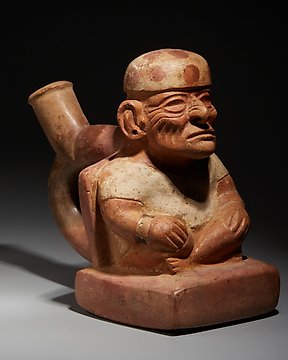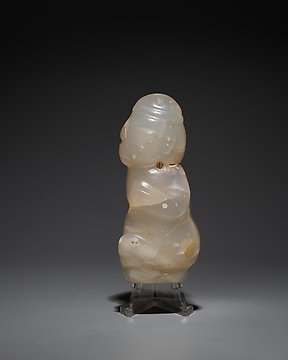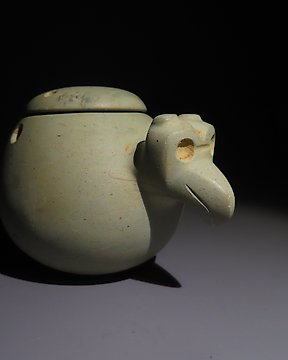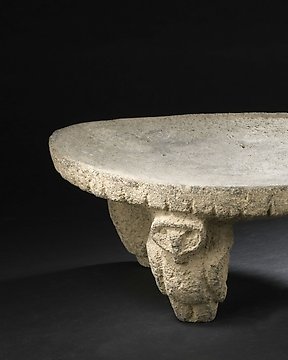Wunderbares Stück. Alles wie beschrieben. Hervorragender Kontakt.
查看翻譯吉安娜島,瑪雅,墨西哥 Terracotta 精美圖。西元 250 - 700 年。 21.5 公分高。西班牙進口許可證。稀有的!
編號 85410173
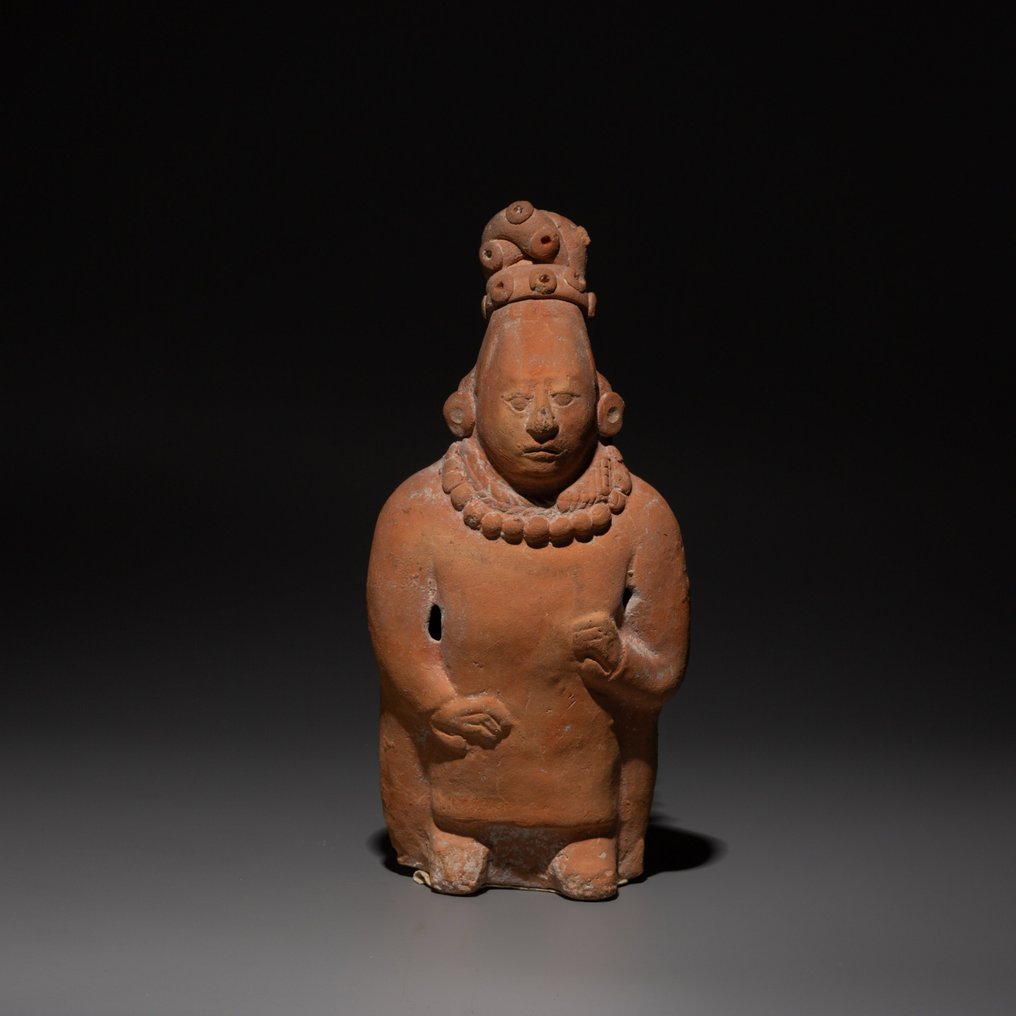

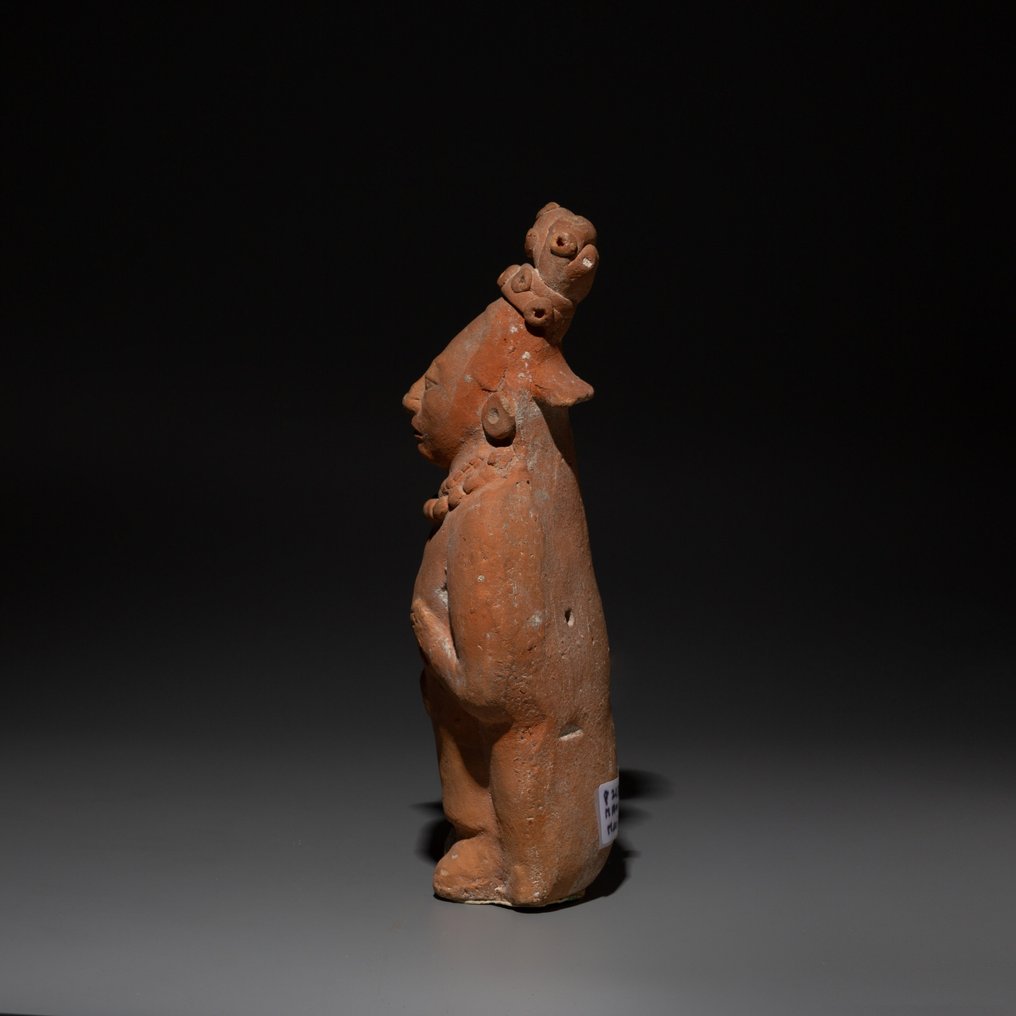
Figure.
Isla de Jaina, Maya, Mexico, 250 - 700 AD.
MATERIAL: Terracotta
DIMENSIONS: Height 21.5 centimeters.
PROVENANCE: Romy Rey Collection, London, 1970.
CONDITION: Good condition.
DESCRIPTION:
Figure of a Mayan dignitary or priest from the island of Jaina. His body is wrapped by a mantle under which a long tunic can be seen, from which the bare feet protrude. It presents a belt richly decorated with bird heads. His face, with oriental features, so characteristic of this type of figures, is finely modeled. Special mention deserves some small balls located in the area of the beard that could well represent tattoos or some type of scarifications. It has large circular earrings and an elongated cap.
Jaina Island is a pre-Columbian Maya archaeological site in the present-day Mexican state of Campeche. A small limestone island on the Yucatán Peninsula's Gulf coast with only a tidal inlet separating it from the mainland, Jaina served as an elite Maya burial site, and is notable for the high number of fine ceramic figurines excavated there.
The term "Jaina" translates to "Temple in the Water". Both Jaina Island and nearby Piedras Island (Isla Piedras) were the sites of small towns or villages. Jaina was settled circa 300 AD, lasting until its abandonment some time circa 1200 CE. The principal occupation occurred near the end of this period, during the Late Classic and Terminal Classic eras. Present-day ruins consist of two small plaza groups and a ballcourt.
Jaina Island's notability is tied to its estimated 20,000 graves, of which over 1,000 have been archaeologically excavated. Within each grave, the human remains are accompanied by glassware, slateware, or pottery as well as one or more ceramic figurines, usually resting on the occupant's chest or held in their hands. The name of this island necropolis probably comes from the Yucatán Maya phrase hail na, or “watery house”. Its western location may have been tied to the setting sun, and therefore to death. The source of the burial population is as yet unknown, but likely comes from Edzna, and the nearby Chenes and Puuc regions.
Due to sheer numbers found here, these figurines have become known as "Jaina-style figurines" whether or not they were found on the Jaina Island. In fact, these figurines are far more numerous at inland Maya sites, such as the Usumacinta River delta, than on the island. Early Jaina-style figures are naturalistic, delicately detailed, and generally regarded as the finest figurine art produced throughout the ancient Americas. While both solid and hollow figurines have been found, the latter predominate and are usually fitted with a whistle, or with clay pellets that produce a rattle-like sound. Like the figurines themselves, it is not known what function(s) the whistles and rattles served. Made of orange clay and originally painted, mostly in ochres and blues, the figurines are generally 25 – 65 cm tall, rarely more. These figures also represent Mayan practices of scarification and the significance of class in Mayan society. Created in a realistic style, the figurines are an ethnographic treasure trove, affording a glimpse into the physical features, dress, and daily life of the late Classic Maya elite. Their delicate detail reveals hallmarks of social status and the figurines are often shown with tools and other accoutrements, providing us three-dimensional snapshots of long-vanished implements.
The idiosyncratic details shown in the earlier phase figurines have led one researcher to declare that they are "genuine essays in portraiture", while another adds that the figurines "faithfully describe age, status, and expression". Expressive and individual as they are, it has thus far proven to be difficult to determine the subjects of these figurines. For example, it is not possible to correlate the figurines with their associated burial. In particular, the gender of the figurines only randomly seem to match the gender of the burial—female figurines may accompany male burials and vice versa, while child burials are often accompanied by adult figurines. Certain figurines, and styles of figurines, have been identified as deities. Others hint at myths or legends. It has also been suggested that the figurines represent ancestors, distant or immediate. The question of portraiture may only be resolved when the function of these grave goods is itself resolved.
All the figurines on Jaina Island seem to have been produced specifically as burial accompaniments. Due, if nothing else, to space considerations, few if any of these figurines could have been produced on the island itself. Many of the molded figurines have been linked to workshops at Jonuta, some distance to the south and west. Fascinatingly, the people around Jaina are the only people in southeastern Mesoamerica who put human figures into graves - everywhere else in the region, figures have only been found in domestic contexts. The use of human figures immediately calls to mind the earlier West Mexican cultures that had extensive figures made solely to be placed in their shaft tombs. The Spaniard Diego de Landa, who recorded details of Mayan life shortly after the Spanish Conquest, wrote that the artists who created pieces like this one lived lives of religious isolation and ritual, fasting and abstaining.
BIBLIOGRAPHY:
- BALL, Joseph. Maya Lowlands: North. Archaeology of Ancient Mexico and Central America. An Encyclopedia Garland Publishing, Inc. 2001.
- COE, Michael D. The Mayas. Thames & Hudson. 1999.
- CORSON, Christopher. Stylistic Evolution of Jaina Figurines, Pre-Columbian Art History. Selected Readings. Peek Publications. 1977.
Notes:
- The piece includes authenticity certificate.
- The piece includes Spanish Export License (Passport for European Union) - If the piece is destined outside the European Union a substitution of the export permit should be requested, can take between 1-2 weeks maximum.
- The seller guarantees that he acquired this piece according to all national and international laws related to the ownership of cultural property. Provenance statement seen by Catawiki.
賣家的故事
Figure.
Isla de Jaina, Maya, Mexico, 250 - 700 AD.
MATERIAL: Terracotta
DIMENSIONS: Height 21.5 centimeters.
PROVENANCE: Romy Rey Collection, London, 1970.
CONDITION: Good condition.
DESCRIPTION:
Figure of a Mayan dignitary or priest from the island of Jaina. His body is wrapped by a mantle under which a long tunic can be seen, from which the bare feet protrude. It presents a belt richly decorated with bird heads. His face, with oriental features, so characteristic of this type of figures, is finely modeled. Special mention deserves some small balls located in the area of the beard that could well represent tattoos or some type of scarifications. It has large circular earrings and an elongated cap.
Jaina Island is a pre-Columbian Maya archaeological site in the present-day Mexican state of Campeche. A small limestone island on the Yucatán Peninsula's Gulf coast with only a tidal inlet separating it from the mainland, Jaina served as an elite Maya burial site, and is notable for the high number of fine ceramic figurines excavated there.
The term "Jaina" translates to "Temple in the Water". Both Jaina Island and nearby Piedras Island (Isla Piedras) were the sites of small towns or villages. Jaina was settled circa 300 AD, lasting until its abandonment some time circa 1200 CE. The principal occupation occurred near the end of this period, during the Late Classic and Terminal Classic eras. Present-day ruins consist of two small plaza groups and a ballcourt.
Jaina Island's notability is tied to its estimated 20,000 graves, of which over 1,000 have been archaeologically excavated. Within each grave, the human remains are accompanied by glassware, slateware, or pottery as well as one or more ceramic figurines, usually resting on the occupant's chest or held in their hands. The name of this island necropolis probably comes from the Yucatán Maya phrase hail na, or “watery house”. Its western location may have been tied to the setting sun, and therefore to death. The source of the burial population is as yet unknown, but likely comes from Edzna, and the nearby Chenes and Puuc regions.
Due to sheer numbers found here, these figurines have become known as "Jaina-style figurines" whether or not they were found on the Jaina Island. In fact, these figurines are far more numerous at inland Maya sites, such as the Usumacinta River delta, than on the island. Early Jaina-style figures are naturalistic, delicately detailed, and generally regarded as the finest figurine art produced throughout the ancient Americas. While both solid and hollow figurines have been found, the latter predominate and are usually fitted with a whistle, or with clay pellets that produce a rattle-like sound. Like the figurines themselves, it is not known what function(s) the whistles and rattles served. Made of orange clay and originally painted, mostly in ochres and blues, the figurines are generally 25 – 65 cm tall, rarely more. These figures also represent Mayan practices of scarification and the significance of class in Mayan society. Created in a realistic style, the figurines are an ethnographic treasure trove, affording a glimpse into the physical features, dress, and daily life of the late Classic Maya elite. Their delicate detail reveals hallmarks of social status and the figurines are often shown with tools and other accoutrements, providing us three-dimensional snapshots of long-vanished implements.
The idiosyncratic details shown in the earlier phase figurines have led one researcher to declare that they are "genuine essays in portraiture", while another adds that the figurines "faithfully describe age, status, and expression". Expressive and individual as they are, it has thus far proven to be difficult to determine the subjects of these figurines. For example, it is not possible to correlate the figurines with their associated burial. In particular, the gender of the figurines only randomly seem to match the gender of the burial—female figurines may accompany male burials and vice versa, while child burials are often accompanied by adult figurines. Certain figurines, and styles of figurines, have been identified as deities. Others hint at myths or legends. It has also been suggested that the figurines represent ancestors, distant or immediate. The question of portraiture may only be resolved when the function of these grave goods is itself resolved.
All the figurines on Jaina Island seem to have been produced specifically as burial accompaniments. Due, if nothing else, to space considerations, few if any of these figurines could have been produced on the island itself. Many of the molded figurines have been linked to workshops at Jonuta, some distance to the south and west. Fascinatingly, the people around Jaina are the only people in southeastern Mesoamerica who put human figures into graves - everywhere else in the region, figures have only been found in domestic contexts. The use of human figures immediately calls to mind the earlier West Mexican cultures that had extensive figures made solely to be placed in their shaft tombs. The Spaniard Diego de Landa, who recorded details of Mayan life shortly after the Spanish Conquest, wrote that the artists who created pieces like this one lived lives of religious isolation and ritual, fasting and abstaining.
BIBLIOGRAPHY:
- BALL, Joseph. Maya Lowlands: North. Archaeology of Ancient Mexico and Central America. An Encyclopedia Garland Publishing, Inc. 2001.
- COE, Michael D. The Mayas. Thames & Hudson. 1999.
- CORSON, Christopher. Stylistic Evolution of Jaina Figurines, Pre-Columbian Art History. Selected Readings. Peek Publications. 1977.
Notes:
- The piece includes authenticity certificate.
- The piece includes Spanish Export License (Passport for European Union) - If the piece is destined outside the European Union a substitution of the export permit should be requested, can take between 1-2 weeks maximum.
- The seller guarantees that he acquired this piece according to all national and international laws related to the ownership of cultural property. Provenance statement seen by Catawiki.
賣家的故事
- 752
- 7
- 0
Extremely rapid courrier service from Barcelona to Flanders, picture was nicely and carefully packaged. Muchas gracias!
查看翻譯Very fine specimen! Thanks.
查看翻譯Top
查看翻譯goede foto's, goede omschrijving, goed verpakt en snel verzonden.
查看翻譯molto bello tutto ok
查看翻譯Pezzo come da descrizione, davvero notevole. Venditore molto consigliato in quanto gentile e disponibile. spedizione molto veloce. Ottimo!
查看翻譯Venditore davvero ottimo e gentile. Merce come da descrizione, spedizione veloce. Ottimo l'avere certificato di autenticità.
查看翻譯Un 100 como empresa un 100 como envío . Empresa muy especial con mucha exquisitez en todos los productos y en personal . Muchas gracias
查看翻譯All well! Thanks.
查看翻譯Very nice and fine cut little jewel! Well packed too! Thanks!
查看翻譯nice piece and very fast shipping!
查看翻譯Es una maravilla de moneda, donde se le nota los pasos de los años y me encanta. Servido muy rápido y bien empaquetado. Con su certificación. Qué más se puede pedir?
查看翻譯Snelle en correcte levering, alleen was de verpakking voor het schilderij niet stevig genoeg.
查看翻譯Herzlichen Dank!
查看翻譯All OK and with very fast shipping.
查看翻譯Prachtig schilderij. Zo blij mee. Zeer nette verkoper en zeer snelle levering.
查看翻譯perfect ! very fast and high quality delivery !
查看翻譯All well! Thanks.
查看翻譯Vendeur très professionnel, top +++×
查看翻譯Photos trop contrastées pour bien percevoir les défauts, mais ces défauts étaient visibles pour autant. Le "Bon état" est trompeur. Sinon, envoi rapide et correctement emballé. Frais de port exagérés.
查看翻譯Great communication, delivery and product. Came with a well made certificate of authenticity and good packaging. Overall very happy with the purchase! Delivery is a bit expensive, but I recommend it
查看翻譯Magnifique témoin du passé, envoyé avec tous les justificatifs, impeccable. Encore une fois très satisfait, un grand merci
查看翻譯Thank you for the Special offer and the fast shipping of this excellent piece of art!
查看翻譯very good description of the object, very good price for this rare item,. Fast sending (has been at my place 2 days after buying!). Definitely would buy again.
查看翻譯- 752
- 7
- 0
Wunderbares Stück. Alles wie beschrieben. Hervorragender Kontakt.
查看翻譯免責聲明
賣家保證並能證明該物品是合法取得的。 Catawiki 通知賣家,他們必須提供其居住國法律要求的文件。 賣家保證並有權出售/出口此物品。 賣家將向買家提供有關該物品的所有已知來源的資訊。 賣家確保已/將安排任何必要的許可證明。 賣家將立即通知買家有關獲得此類許可時的任何延誤。
賣家保證並能證明該物品是合法取得的。 Catawiki 通知賣家,他們必須提供其居住國法律要求的文件。 賣家保證並有權出售/出口此物品。 賣家將向買家提供有關該物品的所有已知來源的資訊。 賣家確保已/將安排任何必要的許可證明。 賣家將立即通知買家有關獲得此類許可時的任何延誤。

